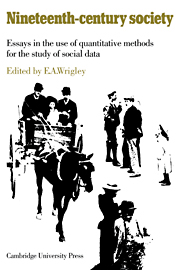Book contents
- Frontmatter
- Contributors
- Contents
- Introduction
- 1 The census, 1801–1891
- 2 The study of family structure
- 3 Sources of inaccuracy in the 1851 and 1861 censuses
- 4 Standard tabulation procedures for the census enumerators' books 1851–1891
- 5 Sampling in historical research
- 6 The use of information about occupation
- 7 The use of published census data in migration studies
- 8 Criminal statistics and their interpretation
- 9 The incidence of education in mid-century
- Notes
- Bibliography
- Index
6 - The use of information about occupation
Published online by Cambridge University Press: 05 November 2011
- Frontmatter
- Contributors
- Contents
- Introduction
- 1 The census, 1801–1891
- 2 The study of family structure
- 3 Sources of inaccuracy in the 1851 and 1861 censuses
- 4 Standard tabulation procedures for the census enumerators' books 1851–1891
- 5 Sampling in historical research
- 6 The use of information about occupation
- 7 The use of published census data in migration studies
- 8 Criminal statistics and their interpretation
- 9 The incidence of education in mid-century
- Notes
- Bibliography
- Index
Summary
PREFATORY NOTE
In these pages, consideration will be given to the best techniques for stratifying and grouping nineteenth-century communities in terms of economic function on the one hand, and social class on the other. The arguments put forward, and schemes to be discussed, are necessarily closely argued and even technical up to a point. It is therefore appropriate to deal with matters such as the need for grouping, and the nature of the basic material which we have to use in a preliminary note.
Ashton has written that economic historians (we might now add social historians) are concerned primarily with groups. Their subject is not Adam, a gardener, but the cultivators of the soil as a class; not Tubal-cain, a skilled artificer in brass and iron, but metal workers or industrialists in general. They deal less with the individual than with the type. The now widely-agreed need to concentrate on the typical and the general rather than the unique or particular reflects perhaps the most fundamental influence of the social sciences on historical methods in this century. There will always remain those who dabble among the sources of history for the quaint and the unusual, and antiquarianism cannot be wholly condemned. But those who hope to see their researches make some contribution to the mainstream development of the subject must necessarily mark Ashton's words well.
In this case we are concerned with social and economic groupings on the national or local level, in the nineteenth century.
- Type
- Chapter
- Information
- Nineteenth Century Society , pp. 191 - 310Publisher: Cambridge University PressPrint publication year: 1972
- 72
- Cited by



